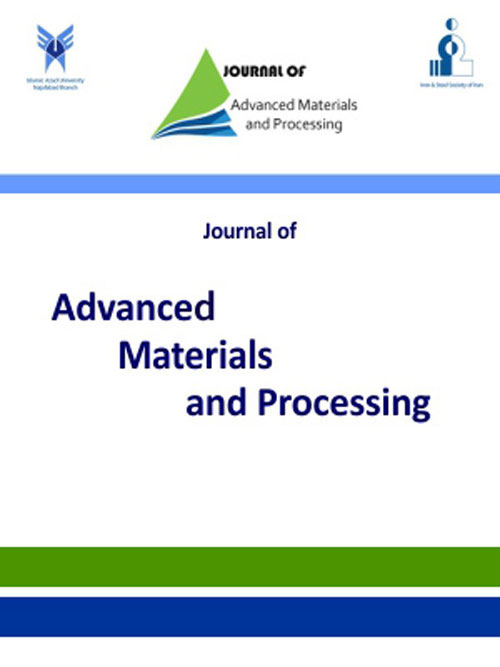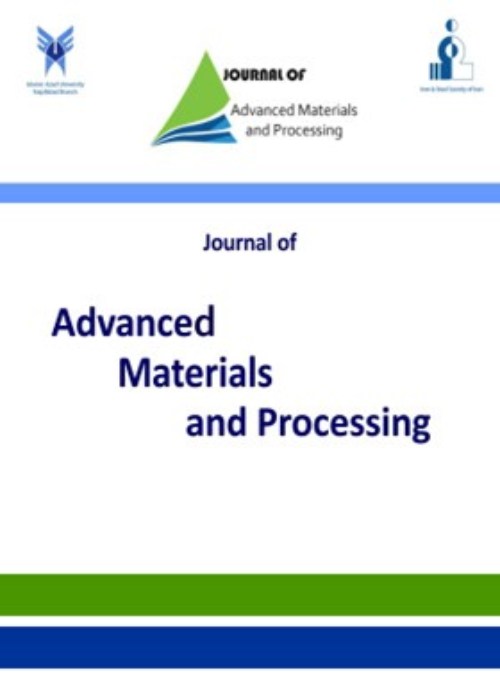فهرست مطالب

Journal of advanced materials and processing
Volume:9 Issue: 4, Autumn 2021
- تاریخ انتشار: 1401/03/17
- تعداد عناوین: 6
-
-
Pages 3-12The aim of this study was to investigate the effect of post-weld intercritical annealing (IA) on the microstructure and tensile properties of a gas tungsten arc-welded DP700 steel sheet. In this regard, DP700 steel sheets were first joined using gas-tungsten arc welding. The welded sheet was then annealed at intercritical temperature of 720 °C for 120 s followed by water quenching. Microstructure and microhardness of the as-welded and post-weld heat-treated samples were characterized, as well as tensile properties. Results showed that the microstructure varied from ferrite-tempered martensite in the subcritical heat affected zone to a mixture of bainite, Widmanestatten ferrite, ferrite-carbide aggregate and grain boundary ferrite in the fusion zone. This heterogeneity in the microstructure led to the formation of hardened and softened zones across the welded joint. Strain localization in the softened zone during tensile testing resulted in a joint efficiency of ~ 81% and early fracture. After post weld IA, dual phase microstructures comprising of ferrite and martensite, with different sizes and morphologies, were formed across the welded joint. This new microstructure resulted in the elimination of hardened and softened zones, which in turn led to high joint efficiency of ~ 98%.Keywords: Dual Phase Steel, welding, intercritical annealing, Tensile strength
-
Pages 13-22A simple polymer-assisted wet chemical method was used to synthesize NiAl2O4 nanopowder. The photocatalytic properties of synthesized powders were investigated for the degradation of methylene blue. For this aim, metal salts and polymeric precursors were dissolved in water, and then a crosslinker was added till a gel was formed. The product was calcined to produce nanopowders. XRD results confirmed the formation of nickel aluminate with spinel structure. In addition, the findings showed that the produced NiAl2O4 nanopowders have a particle size range between 35 to 100 nm with a uniform particle size distribution. The optical properties of the samples showed that the bandgap energy of NiAl2O4 is about 3.44 eV. The nickel aluminate nanopowders demonstrated high photocatalytic activity for photodegradation of methylene blue, which could be attributed to their small particle sizes. It seems that the polymer-assisted wet chemical synthesis may open up an effective route for the production of ceramic photocatalyst nanopowders with high quality.Keywords: NiAl2O4, Nanopowders, Photocatalytic Activity, Wet chemical method
-
Pages 23-34The microstructure and properties of solid oxide fuel cell (SOFC) connected to the fabrication process are discussed in this paper. In this research, we investigate the relationship between electrochemical performance in solid oxide fuel cells and the evolution of the morphology of its electrodes. This work fabricated a planar multilayer anode-supported, anode functional layer (AFL), electrolyte, and cathode solid oxide fuel cell through slurry-based 3D printing. After drying and sintering, scanning electron microscope (SEM) images a multilayer porous structure with large pores up to several microns and smaller pores of 100 nm, and the constituent particles' microstructure for anode-cathode layers were observed. The electrolyte layer structure was dense and without pores. In the study of electrochemical properties, the maximum power density at the output voltage of 0.5 V was achieved at 0.84 W/cm2 at an open-circuit voltage (OCV) of 1.06 V at 800 °C with H2 gas as fuel. The impedance curve values under open-circuit voltage were 0.23 V and 1.25 V at high and low frequencies, respectively.Keywords: Solid oxide fuel cell, 3D Printing, Electrochemical properties, Electrical Conductivity
-
Pages 35-42The high-temperature superconductor like Bi2Ba2Ca2Cu3O10+d was prepared using the solid-state reaction method at different calcination temperatures including 780, 800, and 850 °C. X-ray diffraction technique was used to define crystal structure formation as a function of calcination temperature. It was found a tetragonal phase was obtained with lattice constants of a=b=4.2967, and c=36.5248 Å. It was found that there is a limited difference in the scattered peak intensities making a partial variation in the fraction volume of the phase formation. Such that the volume fraction of a high phase superconductor recorded 73.76% for the Bi-2223 phase at calcination temperature of 800 °C. There is high intensity for the most probable peaks in the prepared sample at a temperature of 800 °C mentioned by peaks (010), (110), and (0116) related to the tetragonal phase. Their intensities were twice incomparable with the peaks that appeared at calcination temperature at around 850 °C. That is returned to high tetragonally and high stability in the atomic distribution within the unit cell. The structure simulation was applied due to the experimental X-ray patterns to investigate the formation of tetragonal shape via a unit cell. A Williamson-Hall method was used to show the crystallite size and the possible strain in the unit cell. It was found the lowest value of strain about (0.0005) appeared at calcination temperature of 800 °C. SEM and EDS had accomplished the surface morphology and elements concentration, their results were confirmed with XRD analysis .Keywords: X-ray diffraction, Williamson-Hall measurements, Calcination temperatures, High-temperature superconductor
-
Pages 43-52
In this study, equal channel angular pressing (ECAP) process with an additional expansion-extrusion stage named expansion-extrusion equal channel angular pressing (EECAP) process is utilized for producing bulk ultrafine grained (UFG) Mg–9Al–1Zn magnesium alloy. In this process, cyclic expansion-extrusion (CEE) and equal channel angular pressing (ECAP) processes are combined. AZ91 magnesium alloy was used for this experiment. An FEM simulation was performed to calculate the compressive hydrostatical stress. Furthermore, microstructural and mechanical properties were investigated. The experimental findings revealed that the ductility of the sample remains almost constant (0.03% drop) while ultimate tensile strength increased about 30%. The average value of microhardness improved from 48 Hv to 65 Hv (35%) and grain size refined from 144 µm to 3.4 µm. Despite the expansion part of the die, there is no need for back pressure. Another advantage of this new method is maintaining ductility while strengthening.
Keywords: EECAP, Ultrafine grained metals, AZ91 alloy, severe plastic deformation -
Pages 53-63
The Persian direct reduction method (PERED) is a suitable method for producing sponge iron on an industrial scale. The challenge of all sponge iron production plants is to supply sponge iron with suitable metallization to steel factories. Accordingly, determining and adjusting the various parameters affecting metallization in each plant is necessary to produce the appropriate amount and quality of sponge iron. In this study, first, the effects of output rate, process flow, water- steam flow rate, bustle temperature, bustle CH4 level, CO2 reform, average pellet size (PIDa), pellet strength (CCS), process gas water temperature, and furnace bed average temperature on spongy iron metallization were investigated. Then, an attempt was made to model the sponge iron grade produced by the PERED method using the Gene Expression Programming (GEP) software. To carry out modeling, data on the affecting variables of metallization were collected for 58 days. The best R2 values for the training and testing sets were 0.974 and 0.27 with a low error rate for both (0.047 and 0.376 in RMSE and 0.001 and 0.141 in MSE, respectively. The results of the sensitivity test indicated that CO2 reform gas, bustle CH4 level, and average pellet size had the most significant effect on metallization.
Keywords: PERED, Direct Reduced Iron (DRI), Gene Expression Programming (GEP), Mathematical modeling


